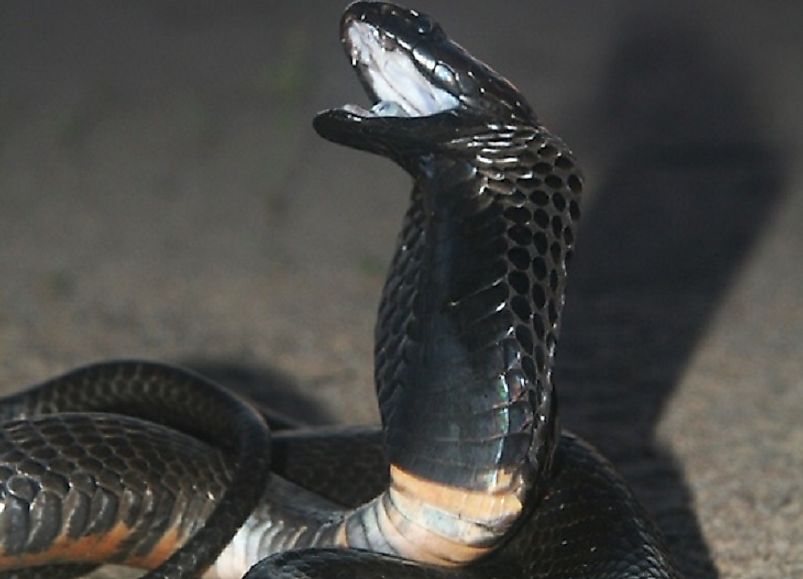Native Reptiles Of Chad

Chad is a landlocked Central African Country that is home to a variety of flora and fauna. It has three climatic zones, namely including the dry Sahara region, which consists of date-palm groves in the oasis, the Sahelian region which consists of palms and acacia trees, and the Sudanic zone with its broad grasslands. The country is home to some native reptile species, some of which are endemic. These include the Mocquard's Writhing Skink, which can be found nowhere else on earth. Others include West African Desert Crocodile, the African Rock Python, the Katian Spitting Cobra, and the Black-Necked Spitting Cobra.
Mocquard’s Writhing Skink (Mochlus mocquardi)
Mocquard’s Writhing Skinks are native to Chad. They live in the dry savannas zone that is in southwest Niger, southern Chad, and in Nigeria. Skinks of the genus mochlus have cylindrical shapes and feed on millipedes and insects. Records of their habitats in the region point at a fragmentary distribution, perhaps reflecting the fragmentation of suitable habitat. They live in dry savannas, preferring the cool, shaded areas having high humidity, usually underneath stones and fallen leaves, in the shade of large trees, and in lowland areas with proximity to water. According to the International Union for the Conservation of Nature's (IUCN) Red List of Endangered Species, they do not face any significant threats, and hence no conservation measures are deemed necessary, though monitoring of habitat quality is recommended.
West African Desert Crocodile (Crocodylus suchus)
The West African desert crocodile is often confused with its cousin, the Nile crocodile. It is found in West Africa, Central Africa, and Uganda. In Mauritania, having adapted to the aridity of the environment, it resides in burrows or caves in aestivation (a hibernation-like state) during the dry season coming out only when it rains, and gathering at gueltas, where the water has collected. It is oviparous reptile. Classified on the IUCN Red list as a species of least concern, the West African desert crocodile does not require conservation efforts.
African Rock Python (Python sebae)
The African rock python has two subspecies, one hailing from Western and Central Africa, and the other from Southern Africa. In addition to being the largest snake on the African continent, it is among the six largest species of snakes worldwide. It prefers to live near water, in various habitats, ranging from near deserts to forests. This non-venomous snake preys on animals as big as antelopes, at times even crocodiles, which it kills by constriction. It may live as long as 12 years in captivity. Though not an endangered species, the African rock python is threatened by human activities such as hunting and by reduction of their habitats.
Katian Spitting Cobra (Naja katiensis)
The Katian Spitting Cobra is a small snake found in West African countries such as Chad, Senegal, Cameroon, Guinea-Bissau, Mali, and Cote d’Ivore, among others. It is a common snake within the Sudanese climatic zone, living in open forest and Savannah. The snake is both diurnal and nocturnal. Its diet consists mainly of amphibians. The IUCN Red List of Endangered Species records that there are no known threats to the Katian spitting cobra, and therefore conservation efforts are not necessary.
Black-Necked Spitting Cobra (Naja nigricollis)
The black-necked spitting cobra is a snake of moderate size, growing to lengths of approximately 1.2 to 2.2 meters. They vary in coloration and markings, depending on region of origin, some being black or pale gray with yellow or reddish ventral side, and others being yellowish brown or of a yellow copper color. Their heads have a distinct shape, due to the presence of two large venom glands, one on each side of the head. Their primary source of food is small rodents such as rats and mice, alongside birds and fish. They are found in most parts of sub-Saharan Africa, inhabiting the savanna and semi-desert regions of the continent. Adapting to geographic location, time of the year, or the average daytime temperature, the black-necked spitting cobra may be either nocturnal or diurnal.
Habitat Loss in Chad
Reptiles and other wildlife in Chad are under threat because of the aggressive deforestation that has taken place in the country with the loss of trees such as baobabs, acacias, dates, and palm trees. This is caused by human activities such as livestock farming and hunting that are a result of increasing human settlements.
Native Reptiles Of Chad
| Native Reptiles of Chad | Scientific Name |
|---|---|
| Mocquard's Writhing Skink | Mochlus mocquardi |
| West African Desert Crocodile | Crocodylus suchus |
| African Rock Python | Python sebae |
| Katian Spittin Cobra | Naja katiensis |
| Black-Necked Spitting Cobra | Naja nigricollis |







